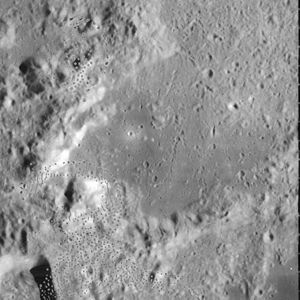Alexander (moon crater)
| Alexander | ||
|---|---|---|

|
||
| Alexander, taken by Lunar Orbiter 4 The stained areas are on the original image |
||
|
|
||
| position | 40.21 ° N , 13.61 ° O | |
| diameter | 93 km | |
| depth | 410 m | |
| Card sheet | 26 (PDF) | |
| Named after | Alexander the Great (356–323 BC) | |
| Named since | 1935 | |
| Unless otherwise stated, the information comes from the entry in the IAU / USGS database | ||
Alexander is a crater-like formation in the northern hemisphere of the Earth's moon . It is located in the rugged terrain north of the Mare Serenitatis between the striking crater Eudoxus in the north-northeast and Calippus in a west-southwest direction. In the northwest is the small crater Lamèch and in the west the mountain range of the Montes Caucasus rises .
Alexander has been so badly deformed and eroded over time that it now looks more like a lowland surrounded by rugged hills than a crater. In the northwest, west and south parts of the original crater walls have been preserved, while the east side is open to the surroundings. The remains of the crater walls are almost rectangular in shape and the highest peaks are in the northwest. The crater floor is smoother on the western side and has a darker color; towards the east it becomes gradually lighter and more marked by impacts. There are no significant impacts within the crater's boundary, although the rougher east face is littered with micro-impacts.

| Letter | position | diameter | link |
|---|---|---|---|
| A. | 40.77 ° N , 14.92 ° E | 4 km | [1] |
| B. | 40.26 ° N , 15.13 ° O | 4 km | [2] |
| C. | 38.51 ° N , 14.93 ° O | 4 km | [3] |
| K | 40.5 ° N , 19.34 ° E | 4 km | [4] |
Web links
- Alexander in the Gazetteer of Planetary Nomenclature of the IAU (WGPSN) / USGS
- Alexander on The-Moon Wiki
- Alexander crater in the "Digital Lunar Orbiter Photographic Atlas of the Moon"
- Lunar Photo of the Day, March 26, 2010
Individual evidence
- ^ John E. Westfall: Atlas of the Lunar Terminator. Cambridge University Press, Cambridge u. a. 2000, ISBN 0-521-59002-7 .

